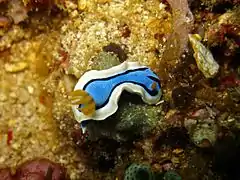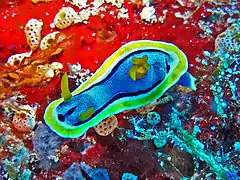| Chromodoris annae | |
|---|---|
 | |
| Scientific classification | |
| Domain: | Eukaryota |
| Kingdom: | Animalia |
| Phylum: | Mollusca |
| Class: | Gastropoda |
| Subclass: | Heterobranchia |
| Order: | Nudibranchia |
| Suborder: | Doridina |
| Superfamily: | Doridoidea |
| Family: | Chromodorididae |
| Genus: | Chromodoris |
| Species: | C. annae |
| Binomial name | |
| Chromodoris annae | |
Chromodoris annae also known as the Anna's magnificent sea slug is a species of sea slug, a very colourful nudibranch, a shell-less marine gastropod mollusc in the family Chromodorididae.[2]
Distribution
This species of nudibranch is found in the central area of the Indo-Pacific region from Malaysia, Indonesia and the Philippines to the Marshall Islands.[3] The Indo-Pacific region that Chromodoris annae can be found in is rich in biodiversity. This is a tropical region made up of shallow waters and expanses of coastal shoreline. It is teeming with many different coral reefs, mangroves, and seagrasses.[4] During the day, the nudibranch is typically found alone within coral reefs.[5] Chromodoris annae can reach depths of between 15-30mm.[6]
Description
Chromodoris annae can reach a maximum size of 5 cm length.[7] The body is elongated, with a foot made distinguishable from the upper body by a skirt-like mantle that partially hides it. The branched gills and the rhinophores are orange to yellow. The main bodily color can be a variety of shades of blue, the intensity of the latter varying from blue-grey to intense blue, slightly speckled by tiny black spots. The blue dorsal side and the foot are bordered with a black line which can be discontinuous depending on the specimen. A black dash between the rhinophores distinguishes this species from similar species like Chromodoris elisabethina and Chromodoris westraliensis. The mantle edge and the foot are bordered with white and orange to yellow lines in which the width and the color intensity can vary greatly from a specimen to another.[3][8][9][10][11][12]
Ecology
Chromodoris annae has a diet that consists of only one group of sponge[6], known as Petrosaspongia sp.[13][14] This nudibranch seeks out this group of sponge due to its noxious chemical composition. Chromodoris annae is able to absorb this compound and store it in glands that stretch around the mantle. These stored chemicals are unpleasant to some surrounding fish, allowing Chromodoris annae to avoid predation.[6] Along with toxin production, it is also believed that the vibrant coloration of Chromodoris annae could be considered aposematic and may be a visual deterrent for predators.[5] Currently, the only predators of Chromodoris annae and others of the Chromodoris species are a carnivorous nudibranch genus Gymnodoris.[15]
Behavior
Generally, Chromodoris annae is a documented docile species of nudibranch. Despite the record of non-aggression, there was one reported case of intraspecific aggression between two Chromodoris annae sea slugs. Both nudibranchs were using a foot to keep them attached to the substrate below, but they were intertwined one on top of the other. They would lunge at each other, presenting their buccal mass and radula in repeated rasping cycles. After some time, the fighting continued with both nudibranchs circling around each other, remaining in close contact and continuing the few second rasping cycles. At one point, one nudibranch reared up and over the other, coming down over the top with its exposed radula. The biting attacks appeared to be targeted, aiming for the head, mantle, and the gills. After some time, both Chromodoris annae specimens moved out of contact with one another. Both of the individuals sustained some minor damage to their mantle.[5]
Reproduction
Chromodoris annae is a planar spawning species, meaning that this nudibranch lays a flat, two-dimensional, egg mass.[16] Chromodoris annae lays egg masses in an arrangement that begins in the center and works its way outward, creating a spiral formation. These eggs are somewhat translucent; however, this nudibranch has a cream-colored ovum, which can then give the egg masses a slight cream-colored hue. Each egg mass consists of approximately 3-4 whorls.[17]
 Chromodoris annae.
Chromodoris annae. Chromodoris annae in the Philippines.
Chromodoris annae in the Philippines. Chromodoris annae in Bunaken, Sulawesi
Chromodoris annae in Bunaken, Sulawesi Chromodoris annae in Bunaken, Sulawesi
Chromodoris annae in Bunaken, Sulawesi.jpg.webp) Chromodoris annae in Wakatobi National Park, Sulawesi, 2016
Chromodoris annae in Wakatobi National Park, Sulawesi, 2016.jpg.webp) Chromodoris annae in Wakatobi National Park, Sulawesi, 2018
Chromodoris annae in Wakatobi National Park, Sulawesi, 2018.jpg.webp) Chromodoris annae meeting in Wakatobi National Park, Sulawesi, 2018
Chromodoris annae meeting in Wakatobi National Park, Sulawesi, 2018
References
- ↑ Bergh L.S.R. (1877). Malacologische Untersuchungen. In: Reisen im Archipel der Philippinen von Dr. Carl Gottfried Semper. Zweiter Theil. Wissenschaftliche Resultate. Band 2, Theil 2, Heft 11, pp. 429-494, pls. 54-57.
- ↑ Caballer, M. (2015). Chromodoris annae Bergh, 1877. In: MolluscaBase (2015). Accessed through: World Register of Marine Species on 2015-12-05
- 1 2 Rudman, W.B., 1998 (November 19) Chromodoris annae Bergh, 1877. [In] Sea Slug Forum. Australian Museum, Sydney.
- ↑ Sanciangco, Jonnell C.; Carpenter, Kent E.; Etnoyer, Peter J.; Moretzsohn, Fabio (2013-02-15). Fontaneto, Diego (ed.). "Habitat Availability and Heterogeneity and the Indo-Pacific Warm Pool as Predictors of Marine Species Richness in the Tropical Indo-Pacific". PLOS ONE. 8 (2): e56245. Bibcode:2013PLoSO...856245S. doi:10.1371/journal.pone.0056245. ISSN 1932-6203. PMC 3574161. PMID 23457533.
- 1 2 3 C. Willan, Richard (2010-01-01). "Intraspecific aggression in the nudibranch Chromodoris annae Bergh, 1877: novel 'fighting' behaviour for the Chromodorididae (Gastropoda, Opisthobranchia)". Basteria. 74 (4/6): 89–94. ISSN 0005-6219.
- 1 2 3 Lin, Geng-Ming; Xiang, Peng; Sampurna, Bonifasius Putera; Hsiao, Chung-Der (2017-12-12). "Genome skimming yields the complete mitogenome of Chromodoris annae (Mollusca: Chromodorididae)". Mitochondrial DNA Part B. 2 (2): 609–610. doi:10.1080/23802359.2017.1372715. ISSN 2380-2359. PMC 7800428. PMID 33473918.
- ↑ Christian Robilliart (2010) Chromodoris annae Sous les Mers.
- ↑ Rudman W.B. (1982) The Chromodorididae (Opisthobranchia: Mollusca) of the Indo-West Pacific: Chromodoris quadricolor, C. lineolata and Hypselodoris nigrolineata colour groups. Zoological Journal of the Linnean Society 76: 183-241.
- ↑ Debelius, Helmut, 2001, Nudibranchs and Sea Snails: Indo-Pacific Field Guide, IKAN - Unterwasserarchiv, Frankfurt, Germany.
- ↑ P.L.Beesley, G.J.B. Ross, A.Wells, Mollusca-The southern synthesis, vol.5, CSIRO, 1998, ISBN 0-643-05756-0
- ↑ David Behrens, Nudibranch behaviour, Newworld Publication INC., 2005, ISBN 978-1878348418
- ↑ Gary Cobb & Richard Willan, Undersea jewels- a colour guide to nudibranchs, Australian Biological Resources Study, 2006, ISBN 0642568472
- ↑ Rudman, W.B., 2004 (Jan 29). Comment on Chromodoris annae on sponge by Roberto Sozzani. [Message in] Sea Slug Forum. Australian Museum, Sydney.
- ↑ Rudman, W. B. & Bergquist, P. R. (2007) A review of feeding specificity in the sponge-feeding Chromodorididae (Nudibranchia: Mollusca). Molluscan Research, 27(2): 60-88
- ↑ Hertzer, Cora; Undap, Nani Ingrid Jacquline; Papu, Adelfia; Bhandari, Dhaka Ram; Aatz, Stefan; Kehraus, Stefan; Kaligis, Fontje; Bara, Robert; Schäberle, Till F.; Wägele, Heike; König, Gabriele M. (2023). "Is a Modified Actin the Key to Toxin Resistance in the Nudibranch Chromodoris? A Biochemical and Molecular Approach". Diversity. 15 (2): 304. doi:10.3390/d15020304. ISSN 1424-2818.
- ↑ Wilson, Nerida G.; Lee, Michael S. Y. (2005-09-01). "Molecular phylogeny of Chromodoris (Mollusca, Nudibranchia) and the identification of a planar spawning clade". Molecular Phylogenetics and Evolution. 36 (3): 722–727. doi:10.1016/j.ympev.2005.04.003. ISSN 1055-7903.
- ↑ Trickey, Jennifer S.; Vanner, Jennifer; Wilson, Nerida G. (2013). "Reproductive variance in planar spawning Chromodoris species (Mollusca: Nudibranchia)". Molluscan Research. 33 (4): 265–271. doi:10.1080/13235818.2013.801394. ISSN 1323-5818.
External links
- Photos of Chromodoris annae on Sealife Collection